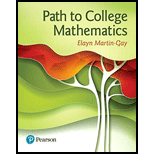
Path To College Mathematics
1st Edition
ISBN: 9780134654409
Author: Martin-Gay, K. Elayn, 1955-
Publisher: Pearson,
expand_more
expand_more
format_list_bulleted
Concept explainers
Question
Chapter 8.2, Problem 27ES
To determine
(a)
Tolist the data items
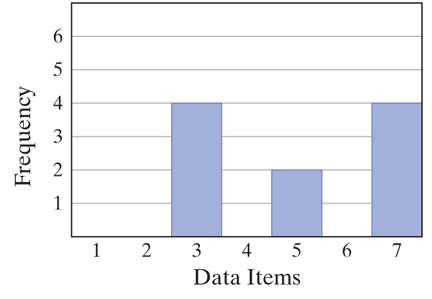
To determine
(b)
The mean of the given data.
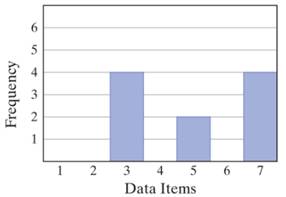
To determine
(c)
The Standard deviation of the given data.
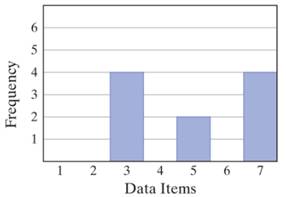
To determine
(d)
The Range of the given data.
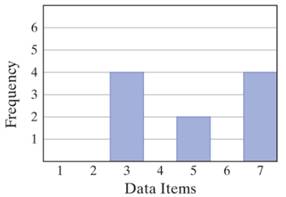
Expert Solution & Answer
Want to see the full answer?
Check out a sample textbook solution
Students have asked these similar questions
2
P(x,y).
kx²y
X: 1,2
5.11273
Find
k
Find P(x/y)
③ Mxy Ng q oxy
ว
> > >
we are
hiring
Salesforce Admin
Location: Remote
Key Responsibilities:
Administer Salesforce Sales & Revenue Cloud (CPQ & Billing)
Configure workflows, validation rules & dashboards
Automate processes using Flows & Process Builder
Collaborate with Sales, Finance & Marketing teams
Manage user roles & security
Apply: Hr@forcecraver.com
3:59 m s
☑
D'Aniello Boutique | Fashion
VOLTE
danielloboutique.it/asia
SUBSCRIBE NOW: 10% OFF TO USE ANYTIME YOU WANT
d'aniello
NEW IN WOMEN
NEW IN MEN
WINTER SALE: 50%
OFF on FW24
SHOP WOMEN
SHOP MEN
Chapter 8 Solutions
Path To College Mathematics
Ch. 8.1 - Prob. 1ESCh. 8.1 - Prob. 2ESCh. 8.1 - For each set of numbers, find the mean, median,...Ch. 8.1 - Prob. 4ESCh. 8.1 - Prob. 5ESCh. 8.1 - Prob. 6ESCh. 8.1 - Prob. 7ESCh. 8.1 - For each set of numbers, find the mean, median,...Ch. 8.1 - Prob. 9ESCh. 8.1 - Prob. 10ES
Ch. 8.1 - Prob. 11ESCh. 8.1 - Prob. 12ESCh. 8.1 - Prob. 13ESCh. 8.1 - The ten tallest buildings in the world, completed...Ch. 8.1 - Prob. 15ESCh. 8.1 - Prob. 16ESCh. 8.1 - Prob. 17ESCh. 8.1 - Prob. 18ESCh. 8.1 - Prob. 19ESCh. 8.1 - During an experiment, the following times (in...Ch. 8.1 - Prob. 21ESCh. 8.1 - Prob. 22ESCh. 8.1 - Prob. 23ESCh. 8.1 - Prob. 24ESCh. 8.1 - Prob. 25ESCh. 8.1 - Prob. 26ESCh. 8.1 - Prob. 27ESCh. 8.1 - Prob. 28ESCh. 8.1 - Prob. 29ESCh. 8.1 - Prob. 30ESCh. 8.1 - Below are lengths for the six longest rivers in...Ch. 8.1 - Prob. 32ESCh. 8.1 - Prob. 33ESCh. 8.1 - Prob. 34ESCh. 8.1 - Prob. 35ESCh. 8.1 - Prob. 36ESCh. 8.1 - Prob. 37ESCh. 8.1 - Prob. 38ESCh. 8.1 - Prob. 39ESCh. 8.1 - Prob. 40ESCh. 8.1 - Prob. 41ESCh. 8.1 - Prob. 42ESCh. 8.1 - Prob. 43ESCh. 8.1 - Prob. 44ESCh. 8.1 - Prob. 45ESCh. 8.1 - Prob. 46ESCh. 8.1 - Prob. 47ESCh. 8.1 - Prob. 48ESCh. 8.1 - Prob. 49ESCh. 8.1 - Prob. 50ESCh. 8.1 - Prob. 51ESCh. 8.1 - Prob. 52ESCh. 8.1 - Prob. 53ESCh. 8.1 - Prob. 54ESCh. 8.1 - Prob. 55ESCh. 8.1 - Prob. 56ESCh. 8.1 - Prob. 57ESCh. 8.1 - Prob. 58ESCh. 8.1 - Prob. 59ESCh. 8.1 - Prob. 60ESCh. 8.1 - Prob. 61ESCh. 8.1 - Prob. 62ESCh. 8.2 - Prob. 1ESCh. 8.2 - Prob. 2ESCh. 8.2 - Find the range for each data set. See Example 1....Ch. 8.2 - Prob. 4ESCh. 8.2 - Prob. 5ESCh. 8.2 - Prob. 6ESCh. 8.2 - Prob. 7ESCh. 8.2 - Prob. 8ESCh. 8.2 - Prob. 9ESCh. 8.2 - Prob. 10ESCh. 8.2 - Prob. 11ESCh. 8.2 - Prob. 12ESCh. 8.2 - Prob. 13ESCh. 8.2 - Prob. 14ESCh. 8.2 - Prob. 15ESCh. 8.2 - Prob. 16ESCh. 8.2 - Prob. 17ESCh. 8.2 - Prob. 18ESCh. 8.2 - Prob. 19ESCh. 8.2 - Prob. 20ESCh. 8.2 - Prob. 21ESCh. 8.2 - Prob. 22ESCh. 8.2 - Prob. 23ESCh. 8.2 - Prob. 24ESCh. 8.2 - Prob. 25ESCh. 8.2 - Prob. 26ESCh. 8.2 - Prob. 27ESCh. 8.2 - Prob. 28ESCh. 8.2 - Prob. 29ESCh. 8.2 - Prob. 30ESCh. 8.2 - Prob. 31ESCh. 8.2 - Prob. 32ESCh. 8.2 - Prob. 33ESCh. 8.2 - Prob. 34ESCh. 8.2 - Prob. 35ESCh. 8.2 - Prob. 36ESCh. 8.2 - Prob. 37ESCh. 8.2 - Prob. 38ESCh. 8.2 - Prob. 39ESCh. 8.2 - Prob. 40ESCh. 8.2 - Prob. 41ESCh. 8.2 - Prob. 42ESCh. 8.3 - Prob. 1ESCh. 8.3 - Prob. 2ESCh. 8.3 - Prob. 3ESCh. 8.3 - Prob. 4ESCh. 8.3 - Prob. 5ESCh. 8.3 - Prob. 6ESCh. 8.3 - Prob. 7ESCh. 8.3 - Prob. 8ESCh. 8.3 - Prob. 9ESCh. 8.3 - Prob. 10ESCh. 8.3 - Prob. 11ESCh. 8.3 - Prob. 12ESCh. 8.3 - Prob. 13ESCh. 8.3 - Prob. 14ESCh. 8.3 - Prob. 15ESCh. 8.3 - Prob. 16ESCh. 8.3 - Prob. 17ESCh. 8.3 - Prob. 18ESCh. 8.3 - Prob. 19ESCh. 8.3 - Prob. 20ESCh. 8.3 - Prob. 21ESCh. 8.3 - Prob. 22ESCh. 8.3 - Prob. 23ESCh. 8.3 - Prob. 24ESCh. 8.3 - Prob. 25ESCh. 8.3 - Prob. 26ESCh. 8.3 - Prob. 27ESCh. 8.3 - Prob. 28ESCh. 8.3 - Prob. 29ESCh. 8.3 - Prob. 30ESCh. 8.3 - Prob. 31ESCh. 8.3 - Prob. 32ESCh. 8.3 - Prob. 33ESCh. 8.3 - Prob. 34ESCh. 8.3 - Prob. 35ESCh. 8.3 - Prob. 36ESCh. 8.3 - Prob. 37ESCh. 8.3 - Prob. 38ESCh. 8.3 - Prob. 39ESCh. 8.3 - Prob. 40ESCh. 8.3 - Prob. 41ESCh. 8.3 - Prob. 42ESCh. 8.3 - Prob. 43ESCh. 8.3 - Prob. 44ESCh. 8.3 - Prob. 45ESCh. 8.3 - Prob. 46ESCh. 8.3 - Prob. 47ESCh. 8.3 - Prob. 48ESCh. 8.3 - Prob. 49ESCh. 8.3 - Prob. 50ESCh. 8.3 - Prob. 51ESCh. 8.3 - Prob. 52ESCh. 8.3 - Prob. 53ESCh. 8.3 - Prob. 54ESCh. 8.3 - Prob. 55ESCh. 8.3 - Prob. 56ESCh. 8.3 - Prob. 57ESCh. 8.3 - Prob. 58ESCh. 8.3 - Prob. 59ESCh. 8.3 - Prob. 60ESCh. 8.3 - Prob. 61ESCh. 8.3 - Prob. 62ESCh. 8.3 - Prob. 63ESCh. 8.3 - Prob. 64ESCh. 8.3 - Prob. 65ESCh. 8.3 - Prob. 66ESCh. 8.3 - Prob. 67ESCh. 8.3 - Prob. 68ESCh. 8.3 - Prob. 69ESCh. 8.3 - Prob. 70ESCh. 8.3 - Prob. 71ESCh. 8.3 - Prob. 72ESCh. 8.3 - Prob. 73ESCh. 8.3 - Prob. 74ESCh. 8.3 - Prob. 75ESCh. 8.3 - Prob. 76ESCh. 8.3 - Prob. 77ESCh. 8.3 - Prob. 78ESCh. 8.3 - Prob. 79ESCh. 8 - Prob. 1VCCh. 8 - Prob. 2VCCh. 8 - Prob. 3VCCh. 8 - Prob. 4VCCh. 8 - Prob. 5VCCh. 8 - Prob. 6VCCh. 8 - Prob. 7VCCh. 8 - Prob. 8VCCh. 8 - Prob. 9VCCh. 8 - Prob. 10VCCh. 8 - Prob. 11VCCh. 8 - Prob. 12VCCh. 8 - Prob. 13VCCh. 8 - Prob. 14VCCh. 8 - Prob. 15VCCh. 8 - Prob. 16VCCh. 8 - Prob. 1RCh. 8 - Prob. 2RCh. 8 - Prob. 3RCh. 8 - Prob. 4RCh. 8 - Prob. 5RCh. 8 - Prob. 6RCh. 8 - Prob. 7RCh. 8 - Prob. 8RCh. 8 - Prob. 9RCh. 8 - Prob. 10RCh. 8 - Prob. 11RCh. 8 - Prob. 12RCh. 8 - Prob. 13RCh. 8 - Prob. 14RCh. 8 - Prob. 15RCh. 8 - Prob. 16RCh. 8 - Prob. 17RCh. 8 - Prob. 18RCh. 8 - Prob. 19RCh. 8 - Prob. 20RCh. 8 - Prob. 21RCh. 8 - Prob. 22RCh. 8 - Prob. 23RCh. 8 - Prob. 24RCh. 8 - Prob. 25RCh. 8 - Prob. 26RCh. 8 - Prob. 27RCh. 8 - Prob. 28RCh. 8 - Prob. 29RCh. 8 - Prob. 30RCh. 8 - Prob. 31RCh. 8 - Prob. 32RCh. 8 - Prob. 33RCh. 8 - Prob. 34RCh. 8 - Prob. 35RCh. 8 - Prob. 36RCh. 8 - Prob. 37RCh. 8 - Prob. 38RCh. 8 - Prob. 39RCh. 8 - Prob. 40RCh. 8 - Prob. 41RCh. 8 - Prob. 42RCh. 8 - Prob. 43RCh. 8 - Prob. 44RCh. 8 - Prob. 1GRFTCh. 8 - Prob. 2GRFTCh. 8 - Prob. 3GRFTCh. 8 - Prob. 4GRFTCh. 8 - Prob. 5GRFTCh. 8 - Prob. 6GRFTCh. 8 - Prob. 7GRFTCh. 8 - Prob. 8GRFTCh. 8 - Prob. 9GRFTCh. 8 - Prob. 10GRFTCh. 8 - Prob. 11GRFTCh. 8 - Prob. 12GRFTCh. 8 - Prob. 1TCh. 8 - Prob. 2TCh. 8 - Prob. 3TCh. 8 - Prob. 4TCh. 8 - Prob. 5TCh. 8 - Prob. 6TCh. 8 - Prob. 7TCh. 8 - Prob. 8TCh. 8 - Prob. 9TCh. 8 - Prob. 10TCh. 8 - Prob. 11TCh. 8 - Prob. 12TCh. 8 - Prob. 13TCh. 8 - Prob. 14TCh. 8 - Prob. 15TCh. 8 - Prob. 16TCh. 8 - Prob. 17TCh. 8 - Prob. 18TCh. 8 - Prob. 19TCh. 8 - Prob. 1CRCh. 8 - Prob. 2CRCh. 8 - Prob. 3CRCh. 8 - Prob. 4CRCh. 8 - Prob. 5CRCh. 8 - Prob. 6CRCh. 8 - Prob. 7CRCh. 8 - Prob. 8CRCh. 8 - Prob. 9CRCh. 8 - Prob. 10CRCh. 8 - Prob. 11CRCh. 8 - Prob. 12CRCh. 8 - Prob. 13CRCh. 8 - Prob. 14CRCh. 8 - Prob. 15CRCh. 8 - Prob. 16CRCh. 8 - Prob. 17CRCh. 8 - Prob. 18CRCh. 8 - Prob. 19CRCh. 8 - Prob. 20CRCh. 8 - Solve: (5x1)(2x2+15x+18)=0.Ch. 8 - Prob. 22CRCh. 8 - Prob. 23CRCh. 8 - Prob. 24CRCh. 8 - Prob. 25CRCh. 8 - Prob. 26CRCh. 8 - Prob. 27CRCh. 8 - Prob. 28CRCh. 8 - Prob. 29CRCh. 8 - Prob. 30CRCh. 8 - Prob. 31CRCh. 8 - Prob. 32CRCh. 8 - Prob. 33CRCh. 8 - Prob. 34CRCh. 8 - Prob. 35CRCh. 8 - Prob. 36CRCh. 8 - Prob. 37CRCh. 8 - Prob. 38CRCh. 8 - Prob. 39CRCh. 8 - Prob. 40CRCh. 8 - Prob. 41CRCh. 8 - Prob. 42CRCh. 8 - Prob. 43CRCh. 8 - Prob. 44CR
Knowledge Booster
Learn more about
Need a deep-dive on the concept behind this application? Look no further. Learn more about this topic, subject and related others by exploring similar questions and additional content below.Similar questions
- JOB UPDATE EMERSON GRAD ENGINEER (FRESHERS) SOFTWARE ENGG NEW RELIC BROWSERSTACK (FRESHERS) SOFTWARE ENGG FULL STACK DATA ENGINEER GENPACT + PYTHON CARS24 WORK FROM HOME #vinkjobs TELE PERFORMANCE Vinkjobs.com CUSTOMER SUPPORT Search "Vinkjobs.com" on Googlearrow_forwardB\ Prove that if T is a spanning tree of G which contains e, then Te Is a spanning tree of G * e.arrow_forward9 Q/ Let G be agraph with n vertices, then G has at least two vertices which are not cut vertices.arrow_forward
- do question 2 pleasearrow_forwardFind the first four nonzero terms in a power series expansion about x=0 for a general solution to the given differential equation w''-14x^2w'+w=0arrow_forwardLet X represent the full height of a certain species of tree. Assume that X has a normal probability distribution with mean 203.8 ft and standard deviation 43.8 ft. You intend to measure a random sample of n = 211trees. The bell curve below represents the distribution of these sample means. The scale on the horizontal axis (each tick mark) is one standard error of the sampling distribution. Complete the indicated boxes, correct to two decimal places. Image attached. I filled in the yellow boxes and am not sure why they are wrong. There are 3 yellow boxes filled in with values 206.82; 209.84; 212.86.arrow_forward
- Answer this questionarrow_forwardIn this exercise, we will investigate a technique to prove that a language is notregular. This tool is called the pumping lemma.The pumping lemma says that if M = (S, I, f, s0, F ) is a DFA with p states (i.e., p = |S|) and if the wordw is in L(M ) (the language generated by M ) and w has length greater than or equal to p, then w may bedivided into three pieces, w = xyz, satisfying the following conditions:1. For each i ∈ N, xy^i z ∈ L(M ).2. |y| > 0 (i.e., y contains at least one character).3. |xy| ≤ p (i.e., the string xy has at most p characters). Use the pumping lemma to show the following language is not regular (HINT: Use proof by contradictionto assume the language is regular and apply the pumping lemma to the language):L = {0^k1^k | k ∈ N}arrow_forwardA prefix of length ℓ of some word w are the first ℓ characters (in order) of w.1. Construct a context-free grammar for the language: L = {w ∈ {a, b}∗ | every prefix of w has at least as many a’s as b’s}2. Explain why every word generated by your context-free grammar (in Part 1) is contained in L. Then,prove via induction that every w ∈ L is produced by your context-free grammar.arrow_forward
- Consider a simplified version of American football where on any possession ateam can earn 0, 3 or 7 points. What is the smallest number n0 of points such that for all n ≥ n0 and n ∈ Na team could earn n points. You must prove that your answer is correct via induction (HINT: Don’t forgetto show that n0 is the smallest number above which any number of points is reachable).arrow_forwardConsider a vocabulary consisting of the nucleotide bases V = {A, T, G, C}.Construct a DFA to recognize strings which end in AAGT .(a) Draw the DFA with clear markings of all states including start and acceptance state(s).(b) Simulate the DFA to show that string T GAAGT will be accepted by the DFA.(c) Simulate the DFA to show that string T AAGT G will not be accepted by the DFA.arrow_forwardA palindrome is a string that reads the same backward as it does forward. For example, abaaaba is a palindrome. Suppose that we need to define a language that generates palindromes.(a) Define a phase structure grammar that generates the set of all palindromes over the alphabet {a, b}clearly describing the recursive rules that generates palindromes. Use the notation Symbol → rule. Theempty set is denoted by λ. Clearly identify the terminal and non-terminal symbols in your grammar.(b) Show that the palindrome abaaaba can be recognized by your grammar. To show this, show all stepsof parsing the expression abaaaba using the rules you defined above.arrow_forward
arrow_back_ios
SEE MORE QUESTIONS
arrow_forward_ios
Recommended textbooks for you
 Holt Mcdougal Larson Pre-algebra: Student Edition...AlgebraISBN:9780547587776Author:HOLT MCDOUGALPublisher:HOLT MCDOUGAL
Holt Mcdougal Larson Pre-algebra: Student Edition...AlgebraISBN:9780547587776Author:HOLT MCDOUGALPublisher:HOLT MCDOUGAL Big Ideas Math A Bridge To Success Algebra 1: Stu...AlgebraISBN:9781680331141Author:HOUGHTON MIFFLIN HARCOURTPublisher:Houghton Mifflin Harcourt
Big Ideas Math A Bridge To Success Algebra 1: Stu...AlgebraISBN:9781680331141Author:HOUGHTON MIFFLIN HARCOURTPublisher:Houghton Mifflin Harcourt College Algebra (MindTap Course List)AlgebraISBN:9781305652231Author:R. David Gustafson, Jeff HughesPublisher:Cengage Learning
College Algebra (MindTap Course List)AlgebraISBN:9781305652231Author:R. David Gustafson, Jeff HughesPublisher:Cengage Learning Functions and Change: A Modeling Approach to Coll...AlgebraISBN:9781337111348Author:Bruce Crauder, Benny Evans, Alan NoellPublisher:Cengage Learning
Functions and Change: A Modeling Approach to Coll...AlgebraISBN:9781337111348Author:Bruce Crauder, Benny Evans, Alan NoellPublisher:Cengage Learning Glencoe Algebra 1, Student Edition, 9780079039897...AlgebraISBN:9780079039897Author:CarterPublisher:McGraw Hill
Glencoe Algebra 1, Student Edition, 9780079039897...AlgebraISBN:9780079039897Author:CarterPublisher:McGraw Hill Algebra: Structure And Method, Book 1AlgebraISBN:9780395977224Author:Richard G. Brown, Mary P. Dolciani, Robert H. Sorgenfrey, William L. ColePublisher:McDougal Littell
Algebra: Structure And Method, Book 1AlgebraISBN:9780395977224Author:Richard G. Brown, Mary P. Dolciani, Robert H. Sorgenfrey, William L. ColePublisher:McDougal Littell

Holt Mcdougal Larson Pre-algebra: Student Edition...
Algebra
ISBN:9780547587776
Author:HOLT MCDOUGAL
Publisher:HOLT MCDOUGAL

Big Ideas Math A Bridge To Success Algebra 1: Stu...
Algebra
ISBN:9781680331141
Author:HOUGHTON MIFFLIN HARCOURT
Publisher:Houghton Mifflin Harcourt

College Algebra (MindTap Course List)
Algebra
ISBN:9781305652231
Author:R. David Gustafson, Jeff Hughes
Publisher:Cengage Learning

Functions and Change: A Modeling Approach to Coll...
Algebra
ISBN:9781337111348
Author:Bruce Crauder, Benny Evans, Alan Noell
Publisher:Cengage Learning

Glencoe Algebra 1, Student Edition, 9780079039897...
Algebra
ISBN:9780079039897
Author:Carter
Publisher:McGraw Hill

Algebra: Structure And Method, Book 1
Algebra
ISBN:9780395977224
Author:Richard G. Brown, Mary P. Dolciani, Robert H. Sorgenfrey, William L. Cole
Publisher:McDougal Littell
The Shape of Data: Distributions: Crash Course Statistics #7; Author: CrashCourse;https://www.youtube.com/watch?v=bPFNxD3Yg6U;License: Standard YouTube License, CC-BY
Shape, Center, and Spread - Module 20.2 (Part 1); Author: Mrmathblog;https://www.youtube.com/watch?v=COaid7O_Gag;License: Standard YouTube License, CC-BY
Shape, Center and Spread; Author: Emily Murdock;https://www.youtube.com/watch?v=_YyW0DSCzpM;License: Standard Youtube License